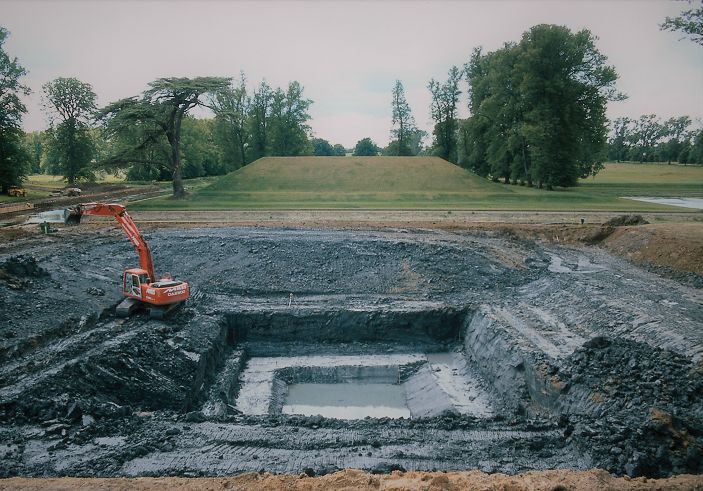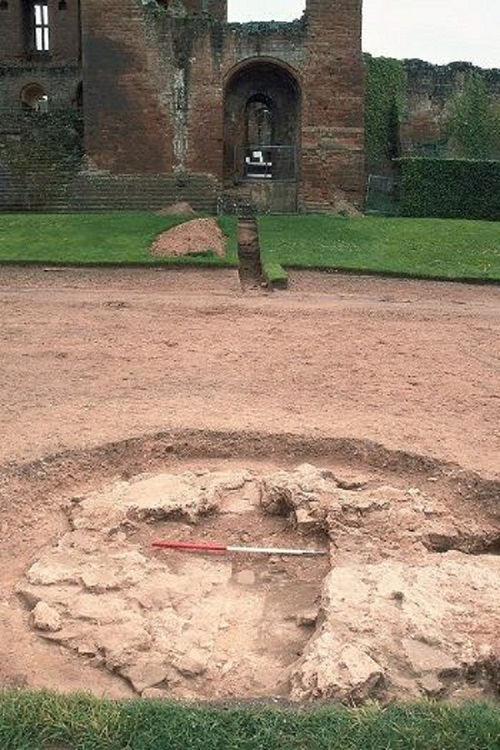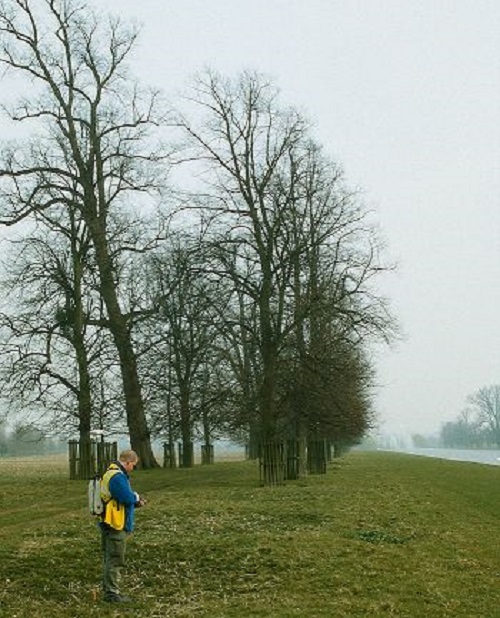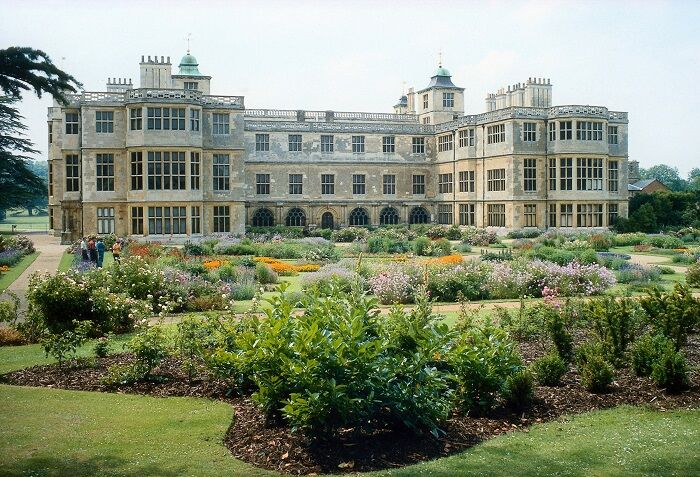Tracing the Past
Archaeology and Garden Reconstruction
Brian Dix
 |
||
| ‘Orpheus’, an inverted pyramid, under construction in the grounds of Boughton House, Northamptonshire: A modern garden feature in keeping with the surrounding historic landscape was introduced after archaeological evaluation, including trial excavation, showed any earlier remains to have been largely destroyed |
Archaeological techniques allow us to rediscover the original form of historic gardens and associated parkland and provide essential information for accurate repair and reconstruction. Yet, by identifying areas of potential sensitivity and importance, such investigation often highlights the tension between preservation, renewal, and enhancement. Some gardens have been accurately restored but others are partial or complete re-creations which attempt to evoke an original spirit rather than to be a faithful reconstruction. While they may occupy the same site as an earlier garden and follow its actual dimensions and layout, they may rely for much of their detail upon the interpretation of previous descriptions and related historical sources, as in the case of the recently refurbished Elizabethan Garden at Kenilworth Castle.
Like its predecessor, which may have been designed expressly for a royal visit in 1575, the garden at Kenilworth is located below the castle keep, where an earthen terrace was constructed both as a processional way and to provide a viewing platform. According to a contemporary report a richly decorated aviary stood directly opposite and there were arbours at each end, with the area between divided into quarters by grass and sand walks, and filled with flowers, fragrant herbs and fruit trees. A tall sculptured fountain stood in the middle and the rediscovery of its foundations proved a vital key to understanding the original geometry. Taken in conjunction with various building dimensions and other measurements recorded in the historical account, the information provides a reliable basis for rebuilding the garden, although much finishing detail remains necessarily speculative and is based on analogy with contemporary practice.
Even where no remains have survived, a carefully conjectured re-creation can provide a vision of what might once have existed. Entirely new gardens built in a scrupulously researched medieval style have been incorporated within appropriate surroundings at Winchester (Queen Eleanor’s Garden) and Tretower Court in Wales, and elsewhere later designs have been copied to enhance the setting of several 17th-century houses. They include the layout of the walled courtyard or bawn at Tully Castle, above Lower Lough Erne in north-west Ulster, together with the arrangement of garden compartments and covered walks around Moseley Old Hall, near Wolverhampton, which draws upon a design from around 1640 that had been used in Yorkshire. More accurate garden reconstructions can equally mislead the unwary. Although the gardens at Ham House, on the bank of the River Thames at Petersham, are based on a plan of the former grounds there, the Cherry Garden lacks any such fruit and reproduces the historical layout with fanciful box-edged beds filled with Dutch and cotton lavenders. Similarly, the reconstruction of the Great Garden at Kirby Hall, Northamptonshire, follows its known layout from the end of the 17th century when George London advised upon changes, but the precise detail of the reintroduced cutwork has been adapted from his design for another property.
 |
|
| Elizabethan Garden, Kenilworth Castle: The form and dimensions of the excavated foundation of the central fountain match those recorded in an Elizabethan description. This information, together with details from the terrace beside the keep, provides the key to understanding the layout of the garden. |
It is easy to promote an illusion of authenticity, although the extent of fabrication, or invention, can be such that it adds an entirely false layer. Caution is required. As garden reconstruction and restoration become more and more a precondition of popular appreciation we must be aware of our intentions, our wishes, and our interpretations of the different historical and archaeological sources available.
EVIDENCE
Many sources of information are available for the study and reconstruction of historic parks and gardens, ranging from contemporary written accounts and other historical documents to a variety of illustrations, including detailed views as well as measured surveys, maps and other plans. None of them was prepared with the needs of the modern inquirer in mind, however, and they remain silent on many aspects that today interest us most. We must qualify the status of the information they contain and sometimes question what they show. For example, the scale and effect of individual features and layout may have been exaggerated through tricks of perspective or artistic licence, or in order to please a patron, and works might be shown which were intended but never completed, or only finished in a different form. Reliance upon such details without means of corroboration may easily result in misrepresenting the historical appearance, together with misunderstanding original purposes. Likewise, building materials may have been deliberately selected in order to provide a contrast of colour and texture, and layout and the choice of plants might emphasise the wealth and importance of the owner, in addition to keeping up with changing fashion.
Archaeological investigation is a vital tool for discovering this kind of detail. At Hampton Court Palace, for example, early 18th-century views show a triangular garden containing a fountain at the south-eastern end of the Privy Garden, even though it appears never to have been constructed. Close physical examination of the area has failed to reveal associated earthworks or other remains, and geophysical survey has also proved negative. Had traces survived, archaeology would be an essential means of identifying their age and character. In addition to ensuring proper understanding of the history and function of surviving garden elements, its results can add knowledge about the wider context that is crucial for site interpretation and management, particularly with respect to future use and development. The historic core of many old gardens is still recognisable and typical elements of rigid landscape design can often be traced from the Middle Ages onwards, as much within existing parkland as beneath modern lawns.
Together with the banks and ditches of former raised walks and moats, lesser scarps and surface depressions betray the presence of early garden features, frequently denoting the lines of former walls and sunken paths. Previous flowerbeds can also be identified in the same way. The designed landscape surrounding a country house might also contain avenues, clumps of trees, shelter belts and other parkland planting, often previously connected with distant garden buildings and other monuments that served as the focal point of vistas or as eye-catching features. Former tree sites and lost alignments may still be visible in the shape of the ground or can be denoted by different vegetation. With abandoned approach routes and winding carriage drives, they build a picture of how the landscape may have been manipulated to impress, or even overawe the visitor. The recognition, careful recording and accurate reinstatement of such traces can therefore revive an important visual amenity as seen both from the house and within the park.
 |
||
| Tully Castle, County Fermanagh: A new garden in the style of an early 17th-century one now occupies the site of the walled courtyard or ‘bawn’ on the south side of the castle that burned in 1641. |
An example of this type of rediscovery can be found in the Home Park at Hampton Court, Surrey, where the avenue-system currently being restored is part of an impressive Baroque landscape that originally radiated from Sir Christopher Wren’s new palace built for King William III and Queen Mary II. It incorporated the earlier planting of a double row of lime trees that had been laid out on each side of the broad canal known as the Long Water, which was created to the east of the palace in 1661. They have also been recently replanted using the historical positions and thereby reproducing the slight inaccuracy of the previous setting out. But clearly this did not matter since the visual appearance looks right.
CONSERVATION ISSUES
In the United Kingdom it is now commonplace for archaeological assessment to underpin most bids for funding the repair and reuse of historical sites. The fundamental contribution of archaeology to good conservation management is widely recognised abroad too, with pertinent studies being carried out in historic parks and gardens from Russia to Romania and Ukraine to the United States, for example, as well as in other parts of Europe and the rest of the world. Individual sites extend from the hanging terraces of a monastic garden on the island of Solovki, at the edge of the Russian Arctic Circle, to Sotterley Plantation on the banks of the Patuxent River, USA, where traces of an earlier layout are preserved in the lawns beside an early colonial mansion.
In Britain, with a tradition of field observation beginning in the 16th century, the sites of abandoned gardens have been recognised in such increasing numbers that they now form one of the most common types of archaeological site. Their examination ranges from the analysis of medieval settings through the rediscovery of Renaissance splendour and Baroque grandeur to the investigation of 18th- and 19th-century designed landscapes, together with later public parks and cemeteries.
By revealing the nature of past gardens and how they developed across time, archaeological study also acknowledges their frequent transformation through the natural stages of growth and decay and there are many instances where we should opt for preserving the quality of repose that comes with age. However, restoration and reconstruction can aid positive conservation if the historical elements (canals, drains, paths, borders, tree pits, etc) are repaired and re-used. Indeed, for many modern visitors, the enjoyment of an historic garden is heightened by the reintroduction of original plant varieties and correct planting to give living form to otherwise esoteric elements.
EXCAVATING HISTORIC GARDENS
 |
|
| Garden of the Solovetsky Monastery in the White Sea, Russia: A favourable microclimate supported the creation of a remarkable garden in the early 19th century, equipped with hotbeds and greenhouses as well as other growing areas. Their remains can be identified together with older features and evidence of later use as a Soviet gulag. | |
 |
|
| Avenues beside the Long Water, Hampton Court: Recording and analysis of lost tree positions enabled the historical arrangement to be recovered, forming the basis for accurate replanting. |
Whereas the lost features of a garden may often be identified through the historical record and by using geophysical survey and other non-intrusive techniques, archaeological excavation is the only method of establishing their actual character and history, particularly where no documents survive. In addition to being an essential stage of subsequent repair or reconstruction, excavation can be further employed to evaluate the extent and condition of any remains, providing information on the constraints of a site.
The need for this type of sensitive approach arose with the proposed introduction of a new garden feature into the 300-year old formal landscape that the first dukes of Montagu had created at Boughton House, near Kettering in Northamptonshire. Since the intended location lay within an early garden compartment, a programme of historical research, on-site survey and archaeological evaluation was commissioned to identify the extent of any related remains and to assess the likely impact upon them. The investigation included archaeological trial excavation, which showed that much significant fabric had been destroyed previously. New use was therefore permitted for Kim Wilkie’s design of ‘Orpheus’ to be constructed within the area of existing disturbance. Its sympathetic geometry and grass slopes fit neatly into the inherited landscape, where the outstanding importance of the original French-inspired grounds is being recovered through ongoing repair and reinstatement of the historic canal system and associated features.
Archaeological investigation and recording enable us to identify the original methods of ground preparation and to restore former profiles, as well as reconstruct previous layouts and planting arrangements. Excavation can range in scale from the clearance of a complete garden plan as preparation for its reinstatement, to the examination of the salient points and key features of the grounds.
The first archaeological work in ancient gardens to reveal the form and nature of their planting was carried out at Pompeii around the start of the 20th century. Excavation at later historic sites soon followed, with pioneer investigations in Virginia, USA and at Kirby Hall in England between the two world wars. However, many earlier restorations were based upon the interpretation of historical plans and views without the benefit of archaeology; or, where there was investigation, it was largely restricted to the examination of isolated features, with most reliance placed on contemporary documents. Now there is awareness of the value of tangible remains, and the combination of clear physical traces and a good historical record has led to the reconstruction of some historic gardens with greater accuracy than was thought possible a few years ago.
At Hampton Court Palace, King William III’s Privy Garden has been reconstructed following the original layout revealed by excavation. Investigation also determined the relative levels between the different parts of the garden, using the evidence of surviving features such as statue plinths, drain funnels and the original rim of the fountain basin. The exact positions of topiary along the terraces could be reconstructed from the rediscovered tree pits, while the brick footings for flights of steps provided an important clue to terrace profiles and their gradients.
Garden archaeology has been equally successful in planning accurate reconstruction elsewhere. At Audley End in Saffron Walden, Essex, for example, the 1830s flower parterre has been restored, incorporating planting based upon a contemporary documented scheme. Likewise, the reconstruction of ornamental beds on the East Parterre at Witley Court, Worcestershire, allows the effects of WA Nesfield’s planting schemes to be rediscovered and increases our understanding of historical gardening techniques. Both are English Heritage sites, but similar investigation underpins accurate reconstruction elsewhere.
 |
||
| Restored formal flower garden at Audley End, Essex: Archaeological excavation confirmed the early 19th-century layout of the parterre with its elaborate pattern of flower beds which have been reinstated to the original plan. |
The scale of individual sites which have been investigated in this way ranges from the designed landscapes of country houses to smaller town gardens and yards from the 18th century onwards, often with surprising results. For example, excavations in the backyards of the ordinary houses in the centre of Colonial Williamsburg suggest that these had been used for growing food rather than flower-gardening.
Floor plans have been recovered from a variety of lost buildings. They range from the largely ornamental, which were incorporated into 18th-century landscape gardens like those at Painshill, Surrey and Hestercombe, near Taunton in Somerset, to the more prosaic greenhouses that were used in kitchen gardens in the 19th and early 20th centuries. Excavation has also uncovered details of grottos and the waterworks associated with them, together with more elaborate cascades like that designed by William Kent, which was built in about 1738 as the headpiece for the river in the grounds of Chiswick House and now recently restored.
Such investigation serves not simply to guide the future repair and reconstruction of garden features but also permits a better understanding of the history and sociology of garden design. The seeds so planted will continue to grow.



